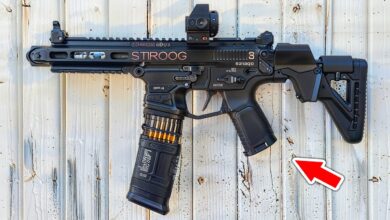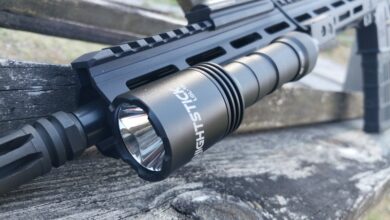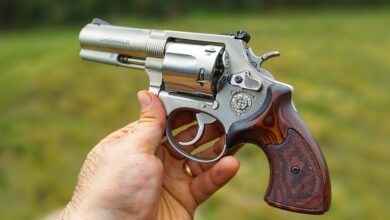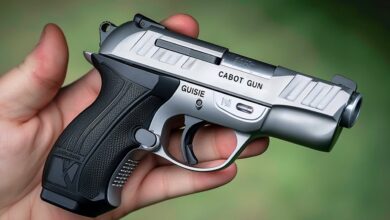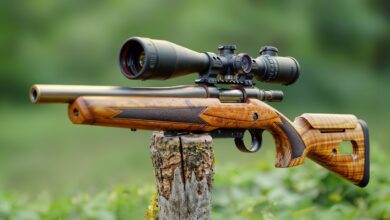Strapping Up with the XFive P320 Conversion

The P320 series of pistols weren’t the first to use a removable fire control system and won’t be the last. Sig Sauer was the first to embrace the modular nature wholeheartedly. They provided a ton of grip modules and caliber conversions for you to make the most out of your P320 series pistol. I’ve been a big fan of the P320, which has quite a few grip modules and slides that allow me to tailor the gun to a wide variety of uses. My latest acquisition, sent by GunMag Warehouse, is the XFive Conversion kit.
Specifically, the XFive TXG X-Change Kit. That’s a bit too much to constantly type, so we’ll call it the XFive. The XFive lineup of Sig Sauer pistols are guns that stretch the barrel a bit beyond full size. The Five in XFive is a reference to the barrel length, and the 5-inch barrel length is just a hair longer than the full-sized P320’s 4.7-inch barrel.
My normal P320 features a compact-length slide and a Mirzon aftermarket grip module, and that’s what I’m used to shooting. I grabbed the XFive Conversion kit to give myself a little more of an advantage for competition shooting, and that’s exactly what it’s intended for. The installation and conversion are super simple.
Remove the slide from your gun, pop out the disassembly lever, and then you can remove the Fire Control Unit. Now, you take the FCU, drop it into the TXG grip module, reinsert the disassembly lever, and install the XFive slide. That’s all there is to it.
The Rundown of the XFive Kit
The XFive is more than a 5-inch barrel and matching slide. Sig Sauer crafted that barrel from stainless steel, and it features a recessed crown. Both the crown and barrel material lend themselves well to enhanced accuracy. The slide does feature lightening cuts across the top. The purpose is to lighten the slide to reduce recoil. A lighter slide means less felt recoil for the user.
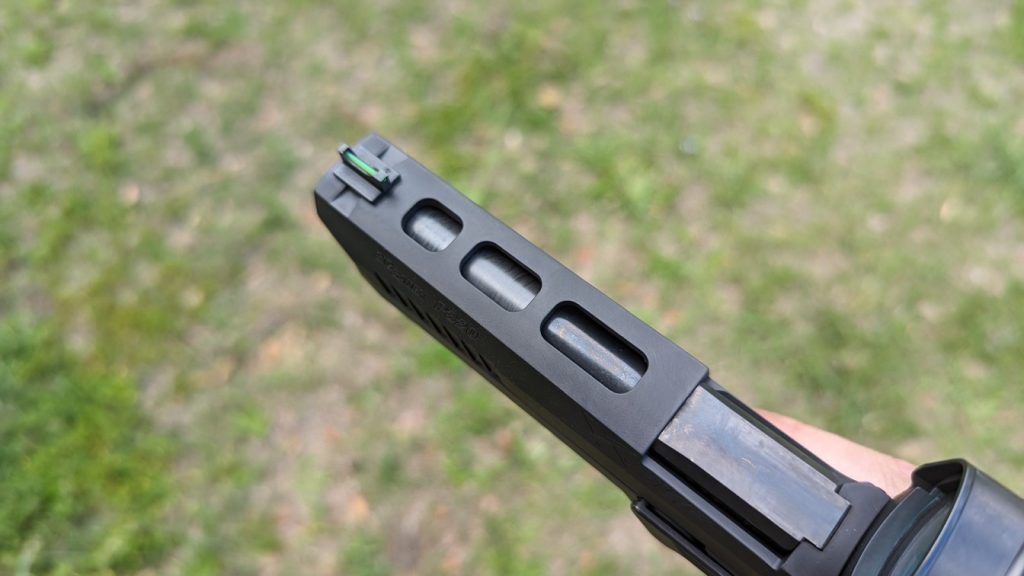
The XFive slide also features the Pro Cut optics cut. I chose a ROMEO1PRO for this particular setup. This slide cut requires you to remove the rear sight, which is a bit lame, but I managed. The included iron sights are high-visibility fiber optic sights.
The TXG grip module delivers a fairly interesting design. The T in TXG stands for tungsten. This grip module is infused with tungsten to increase the weight, which reduces recoil. The tungsten weight makes this whole setup heavier than an M1911, even though the grip is still polymer. You get the recoil-reducing effect of polymer with the recoil-reducing effect of weight. The entire XFive setup weighs 43.5 ounces.

To no one’s surprise, the TXG grip module has a full-length Picatinny rail. Toss on a light, and you might get the weight up to 50 ounces overall. The TXG also comes with a wider magwell for quicker reloads. The rear of the grip has a nice beavertail to allow your hand to get up nice and high for increased control. The XFive has the X Series grip texture and ergonomically shaped grip design. The conversion kit comes with two 17-round magazines. Let’s see how all these fancy features come together and run.
Ringing Steel
I zeroed my ROMEO1PRO to the XFive in short order. At 25 yards, it was utterly addicting to ring this ten-inch gong I have. The XFive setup makes it incredibly easy to keep the gong swinging. I decided to step it out to 50 yards and take some shots at the gong. I could hit the gong regularly, but this time, I had to wait between shots for it to stop swinging.
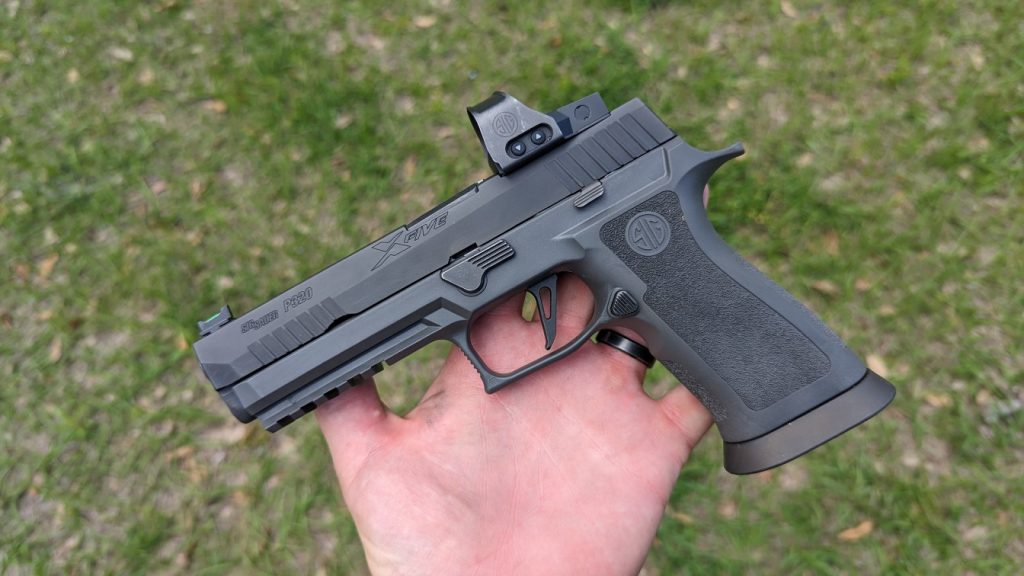
I had a steel IPSC target downrange and decided to give it a few shots. I could hit that booger with every single shot. Every time I pulled the trigger, I heard the reassuring ding as the round struck steel. I could even press double taps and get both on target. The gun barely moves as it recoils, and tracking the red dot back to the target was insanely easy. I even integrated some draws to fire from my Blackhawk P320 L2C holster.
I could put a round onto target in less than two seconds from the draw at fifty yards. I’ll happily take that. I’ve never really gone beyond fifty yards with a handgun, but call me cocky. I stepped back to 75 yards. I didn’t draw this time, but I took my time and fired five offhand shots. My first was a miss, but the next four generated that ding I was looking for.
Just No Way
“There’s no way…. You can’t do it. Bullet drop is going to be insane,” I thought to myself, and I looked behind me. Twenty-five yards behind me was my 100-yard line. I stepped back slowly but steadily. Kept the gun unloaded and aimed, making sure I could see the target, and I dry-fired a few times.
I loaded a magazine up with five rounds, made sure to aim slightly high on the target with a good, steady grip, and pulled the trigger without moving the dot. Admittedly, the first two were misses and then a hit! Then another miss, and finally, one more hit! Two out of five isn’t great, but I couldn’t believe I made a single shot at 100 yards with a handgun. Now, I’m utterly addicted to the idea of shooting targets at 100 yards with a handgun.
Up Close and Personal
Oh boy, let’s bring the gun back to its safe space of close-range shooting. I’ve been trying to conquer something known as the Kill Card Drill. It’s eight rounds fired on three targets from the draw with two reloads, and you have seven seconds to complete it. It’s not super easy, but it’s fun and challenging.
It was a great way to test the gun. I didn’t quite make the seven-second time, but I got the best time I ever had at 7.87 seconds. My ultimate goal is to do a six-second Kill Card Drill, and I plan to keep working on it. Up close, the gun performed very well. The low recoil and flat shooting design make the weapon super easy to handle, almost faster than I can perceive. I think there is a skill gap I need to get across to take this XFive setup to the next level. The XFive magazines have a metal base plate that adds weight and allows them to drop free every time the button is pushed.
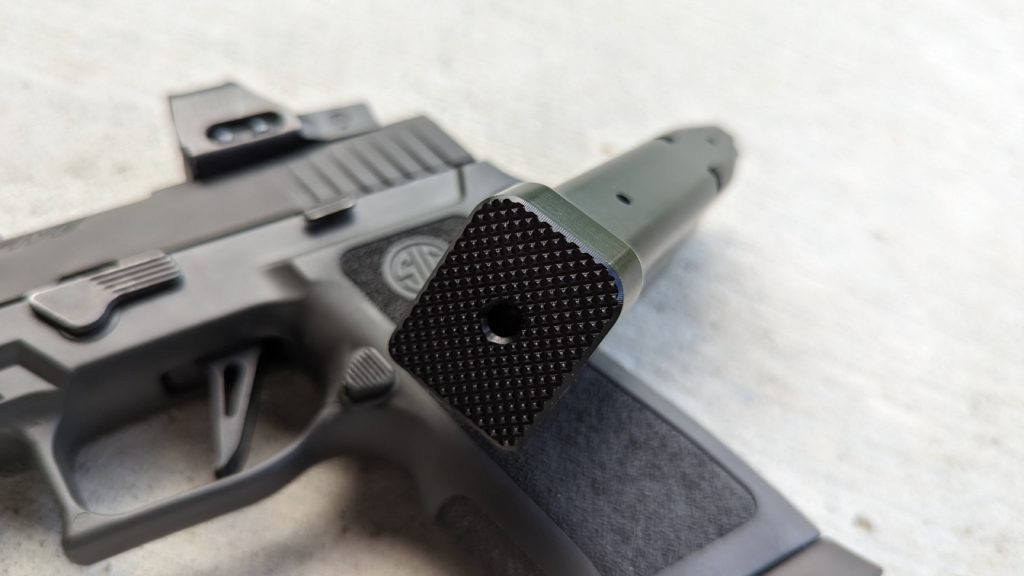
Accuracy wasn’t an issue. The Kill Card Drill uses two small targets and one roughly A Zone-sized rectangle. I could drill those small targets without a problem. I just needed to find a way to shorten the time between shots by hitting that trigger faster. It’s like my muscle memory is still used to a more violent recoil impulse, and I don’t realize I can go faster. That is my next goal: put the pedal to the metal and let it rip.
The XFive Difference
The XFive can take your P320 to the next level. It’s obviously not going to be the best choice for concealed carry owing to its weight and size. However, the gun handles like a dream. For competition, it’s a must-have. Part of the charm of the P320 is its modularity. The fact I can swap my carry gun for a competition gun is downright impressive. The XFive is a well-thought-out design that delivers extreme accuracy and excellent performance. It’s a sports car.
Now, if you’ll excuse me, I have to try to get a little more consistent at 100 yards.
The post Strapping Up with the XFive P320 Conversion appeared first on The Mag Life.
Read the full article here

